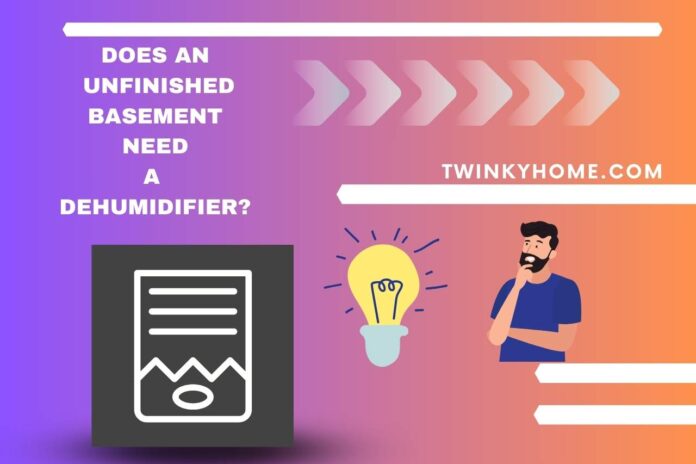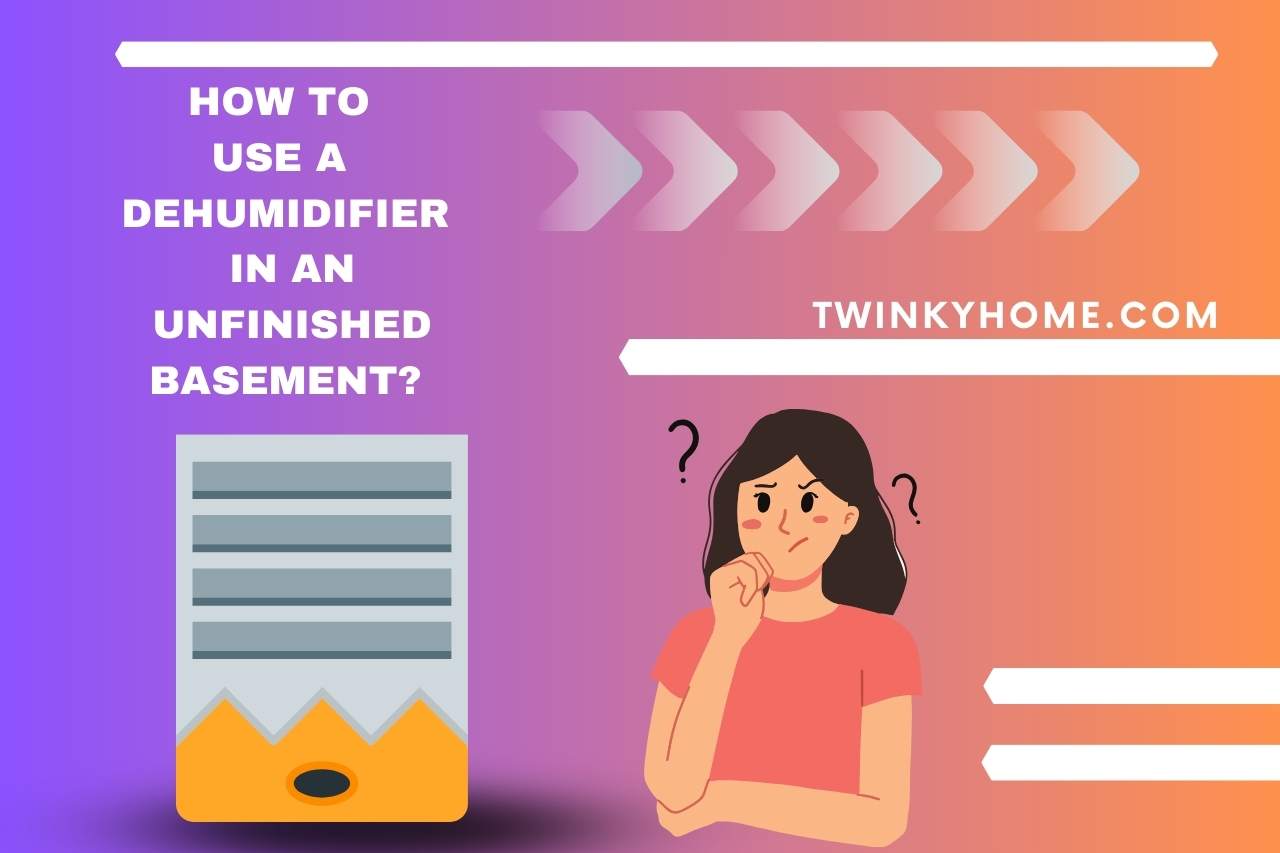The dehumidifier does a great job by reducing the excessive moisture in your basement. But if your basement is not completely finished yet, you might wonder whether an unfinished basement needs a dehumidifier. Actually, unfinished basements can be exposed to more moisture than finished basements, so it is a wise idea to utilize a dehumidifier. When you go through the following detailed paragraphs, you will get a clearer idea about this necessary home investment.
Does an Unfinished Basement Need a Dehumidifier?
Yes, an unfinished basement will need a dehumidifier. While finished basements are commonly associated with living spaces, unfinished basements are also susceptible to high humidity levels and moisture issues, especially if they are not enclosed properly. Here’s why you might consider a dehumidifier for your unfinished basement:
- Preventing Mold and Mildew: Unfinished basements often lack proper insulation and ventilation, making them prone to dampness. As a result, there is a chance for mold and mildew growth, and it can be harmful to both the structure and your health.
- Protecting Stored Items: If you use your unfinished basement for storage, excess humidity can damage items such as clothing, books, and furniture. A dehumidifier helps maintain a drier environment, preserving the integrity of stored belongings.
- Preventing Musty Odors: Damp environments in unfinished basements can contribute to musty odors, too. A dehumidifier helps reduce moisture, minimizing the likelihood of unpleasant smells.
- Improving Air Quality: Excessive humidity can contribute to poor indoor air quality. By maintaining optimal humidity levels, a dehumidifier can create a healthier and more comfortable environment in your unfinished basement.
Make sure to monitor humidity levels regularly and consider using a dehumidifier if levels consistently exceed the recommended range of 30-50%. Additionally, proper ventilation, sealing any leaks or cracks, and addressing drainage issues can complement the effectiveness of a dehumidifier in maintaining a dry and healthy unfinished basement.
How to Use a Dehumidifier in an Unfinished Basement?
Using a dehumidifier in an unfinished basement can significantly improve air quality and prevent moisture-related issues. Here, we have described the entire procedure for using it properly, starting with the right selection.
- Choose the Right Size: Select a dehumidifier with an appropriate capacity for the size of your unfinished basement. You should consider factors like cubic footage, moisture severity, and any unique conditions in the space.
- Central Placement: Position the dehumidifier in a central location to maximize its coverage. This helps ensure even dehumidification throughout the entire basement.
- Set the Right Humidity Level: Adjust the dehumidifier to maintain a humidity level between 30-50%. This range is optimal for preventing mold growth and maintaining a comfortable environment.
- Continuous Drainage: If it is possible, use the dehumidifier’s continuous drainage option by connecting a hose to a floor drain or sump pump. This eliminates the need for manual emptying of the water collection bucket.
- Regular Emptying: If continuous drainage is not feasible, make sure to check and empty the water collection bucket regularly to prevent overflow. Some dehumidifiers feature auto-shutoff when the bucket is full.
- Utilize Drainage Options: If a floor drain or sump pump is not available, consider using a condensate pump to lift and pump the collected water to a suitable drainage point.
- Monitor Humidity Levels: After you start operating the dehumidifier, it is recommended to use a hygrometer to monitor humidity levels regularly. Then, adjust the dehumidifier settings based on seasonal changes or specific humidity patterns in the unfinished basement.
- Ventilate the Space: Improve ventilation by using fans or opening windows when weather permits. Proper airflow aids the dehumidification process.
- Seal Leaks and Cracks: Additionally, seal any visible leaks or cracks in the basement walls and floor. This helps minimize the entry of external moisture and enhances the dehumidifier’s effectiveness.
- Regular Maintenance: Clean the dehumidifier’s filter regularly to ensure optimal performance. Follow the manufacturer’s guidelines for maintenance tasks.
Does an Unfinished Basement Need a Dehumidifier?
The dehumidifier does a great job by reducing the excessive moisture in your basement. But if your basement is not completely finished yet, you might wonder whether an unfinished basement needs a dehumidifier.
Actually, unfinished basements can be exposed to more moisture than finished basements, so it is a wise idea to utilize a dehumidifier.
When you go through the following detailed paragraphs, you will get a clearer idea about this necessary home investment.
Does an Unfinished Basement Need a Dehumidifier?
Yes, an unfinished basement will need a dehumidifier. While finished basements are commonly associated with living spaces, unfinished basements are also susceptible to high humidity levels and moisture issues, especially if they are not enclosed properly. Here’s why you might consider a dehumidifier for your unfinished basement:
- Preventing Mold and Mildew: Unfinished basements often lack proper insulation and ventilation, making them prone to dampness. As a result, there is a chance for mold and mildew growth, and it can be harmful to both the structure and your health.
- Protecting Stored Items: If you use your unfinished basement for storage, excess humidity can damage items such as clothing, books, and furniture. A dehumidifier helps maintain a drier environment, preserving the integrity of stored belongings.
- Preventing Musty Odors: Damp environments in unfinished basements can contribute to musty odors, too. A dehumidifier helps reduce moisture, minimizing the likelihood of unpleasant smells.
- Improving Air Quality: Excessive humidity can contribute to poor indoor air quality. By maintaining optimal humidity levels, a dehumidifier can create a healthier and more comfortable environment in your unfinished basement.
Make sure to monitor humidity levels regularly and consider using a dehumidifier if levels consistently exceed the recommended range of 30-50%. Additionally, proper ventilation, sealing any leaks or cracks, and addressing drainage issues can complement the effectiveness of a dehumidifier in maintaining a dry and healthy unfinished basement.
How to Use a Dehumidifier in an Unfinished Basement?
Using a dehumidifier in an unfinished basement can significantly improve air quality and prevent moisture-related issues. Here, we have described the entire procedure for using it properly, starting with the right selection.
- Choose the Right Size: Select a dehumidifier with an appropriate capacity for the size of your unfinished basement. You should consider factors like cubic footage, moisture severity, and any unique conditions in the space.
- Central Placement: Position the dehumidifier in a central location to maximize its coverage. This helps ensure even dehumidification throughout the entire basement.
- Set the Right Humidity Level: Adjust the dehumidifier to maintain a humidity level between 30-50%. This range is optimal for preventing mold growth and maintaining a comfortable environment.
- Continuous Drainage: If it is possible, use the dehumidifier’s continuous drainage option by connecting a hose to a floor drain or sump pump. This eliminates the need for manual emptying of the water collection bucket.
- Regular Emptying: If continuous drainage is not feasible, make sure to check and empty the water collection bucket regularly to prevent overflow. Some dehumidifiers feature auto-shutoff when the bucket is full.
- Utilize Drainage Options: If a floor drain or sump pump is not available, consider using a condensate pump to lift and pump the collected water to a suitable drainage point.
- Monitor Humidity Levels: After you start operating the dehumidifier, it is recommended to use a hygrometer to monitor humidity levels regularly. Then, adjust the dehumidifier settings based on seasonal changes or specific humidity patterns in the unfinished basement.
- Ventilate the Space: Improve ventilation by using fans or opening windows when weather permits. Proper airflow aids the dehumidification process.
- Seal Leaks and Cracks: Additionally, seal any visible leaks or cracks in the basement walls and floor. This helps minimize the entry of external moisture and enhances the dehumidifier’s effectiveness.
- Regular Maintenance: Clean the dehumidifier’s filter regularly to ensure optimal performance. Follow the manufacturer’s guidelines for maintenance tasks.
You May Also Like
- How to Drain a Basement Dehumidifier? Step-by-Step Guide
- How Long for Dehumidifier to Dry Basement? Unveiling the Drying Magic!
- How to Clean Basement Dehumidifier? Crystal Clear Air!
- How to Keep the Basement Dry Without a Dehumidifier? (Tips & Tricks)
- Does Dehumidifier in Basement Help Upstairs? The Ripple Effect!
- Whole House Dehumidifier vs Basement Dehumidifier – Choosing Wisely!
- How to Choose the Right Dehumidifier for the Basement? Basement Bliss!
- Why does My Basement Dehumidifier Ice Up? Decoding Dehumidifier Woes!
- Can you Run Two Dehumidifiers in the Basement? (Ins and Outs)








![OGX Biotin And Collagen Shampoo Review [Updated One] Ogx Biotin And Collagen Shampoo Review](https://twinkyhome.com/wp-content/uploads/2022/03/Are-chicken-Super-Noodles-vegetarian-1-100x70.jpg)